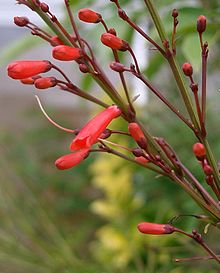Russelia equisetiformis
| Russelia equisetiformis | ||||||||||||
|---|---|---|---|---|---|---|---|---|---|---|---|---|

Flowering shrub |
||||||||||||
| Systematics | ||||||||||||
|
||||||||||||
| Scientific name | ||||||||||||
| Russelia equisetiformis | ||||||||||||
| Schltdl. & Cham. |
Russelia equisetiformis , also known as Russelie , is a shrub-like representative of the plantain family (Plantaginaceae) with scarlet flowers. The distribution area is in Mexico and in Central and South America. The species is often used as an ornamental plant in the tropics and subtropics.
description
Russelia equisetiformis grows as a densely branched shrub up to 1.5 meters high with rod-shaped, upright to spreading branches and numerous thin and overhanging branches. The leaves are small and lanceolate to linear at the base of the shoots, and scale-shaped in the upper areas. The flowers grow nodding in two to three in loose, lively bunches along the shoots. The calyx is small and deeply split. The corolla is a scarlet tube about 2.5 centimeters long. Their hem is two-lipped and split five times, the sections in between are rounded.
Yellow capsule fruits are formed as fruits .
The number of chromosomes is 2n = 20.
distribution
The natural range is in Mexico, in Central America, on the West Indies , in Guiana, Colombia and Peru.
ecology
Like many other red flowering plants of the tropics, the species is pollinated by hummingbirds and other nectar birds .
Systematics and research history
Russelia equisetiformis is a species of the genus Russelia in the plantain family (Plantaginaceae). It was first described in 1831 by Diederich von Schlechtendal and the German poet Adelbert von Chamisso in Linnaea . The generic name Russelia is reminiscent of the Scottish doctor and natural scientist Alexander Russell (around 1715 to 1768). The specific epithet equisetiformis refers to the shoots of the species, which are similar to those of horsetail ( Equisetum ). A synonym of the species is Russelia juncea Zucc.
use
The species blooms abundantly and permanently and is widespread as an ornamental shrub in the tropics and subtropics. In Mediterranean gardens it is sometimes found as a container plant.
Individual evidence
- ↑ a b c d Andreas Bärtels: Tropical Plants , p. 155.
- ↑ Russelia equisetiformis at Tropicos.org. In: IPCN Chromosome Reports . Missouri Botanical Garden, St. Louis
- ↑ Russelia equisetiformis in the Germplasm Resources Information Network (GRIN), USDA , ARS , National Genetic Resources Program. National Germplasm Resources Laboratory, Beltsville, Maryland.
- ↑ Russelia equisetiformis. In: The International Plant Name Index. Retrieved November 30, 2014 .
- ↑ Helmut Genaust: Etymological dictionary of botanical plant names. 3rd, completely revised and expanded edition. Nikol, Hamburg 2005, ISBN 3-937872-16-7 , p. 547 (reprint from 1996).
- ↑ Helmut Genaust: Etymological dictionary of botanical plant names. 3rd, completely revised and expanded edition. Nikol, Hamburg 2005, ISBN 3-937872-16-7 , p. 232 (reprint from 1996).
- ↑ Russelia equisetiformis. In: The Plant List. Retrieved November 30, 2014 .
literature
- Andreas Bärtels: Tropical Plants . Ornamental and useful plants. 5th, revised edition. Eugen Ulmer Verlag, Stuttgart 2002, ISBN 3-8001-3937-5 , p. 155 .
